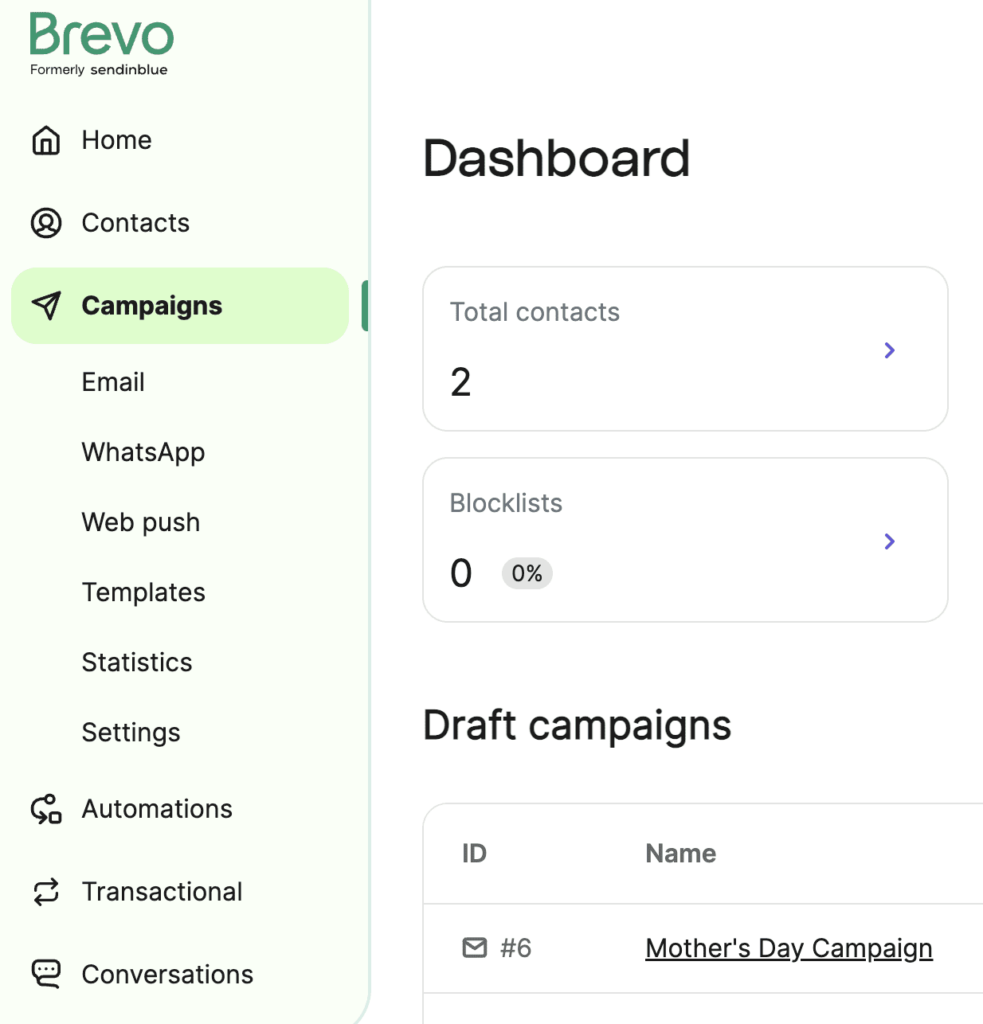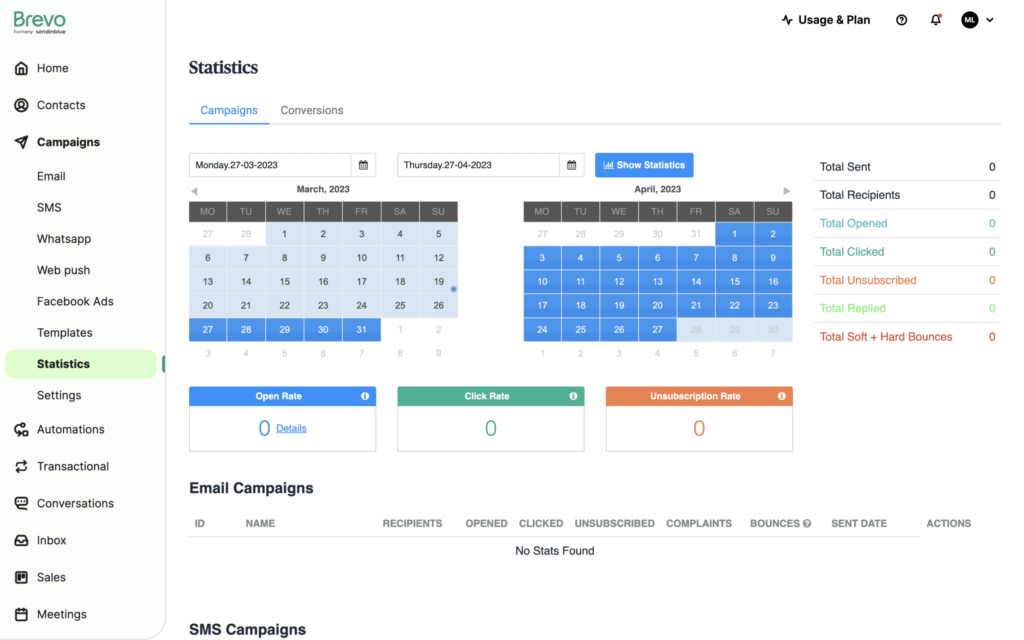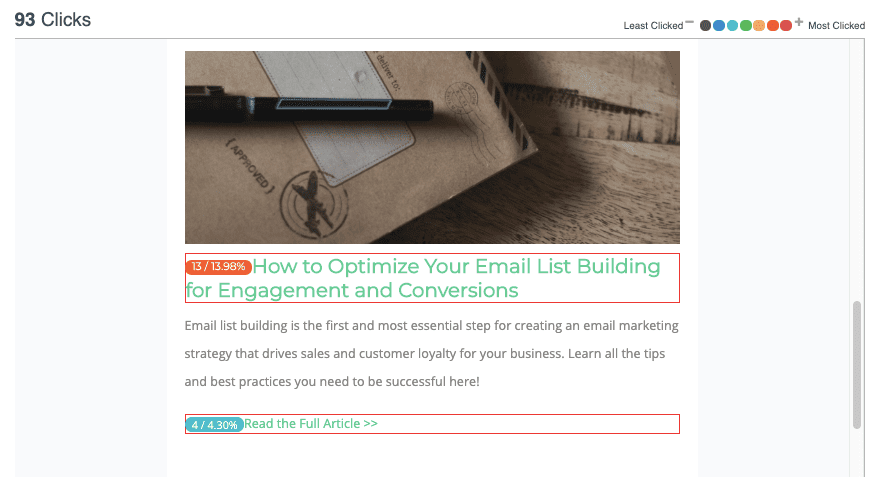To improve your email marketing strategy and reach your goals, you’ll need to constantly be monitoring campaign performance. But what metrics should you focus on?
In this article, we’ll walk you through the most important email marketing KPIs and how to stay on top of your performance.
17 email marketing KPIs to track
Email marketing metrics, or key performance indicators (KPIs), offer a quantifiable way to gauge your email campaigns’ effectiveness. Here are 17 metrics every email marketer should understand.
1. Email Delivery Rate
The email delivery rate is a metric used to measure how many emails were delivered to the servers of your recipients’ email service providers.
How to measure it
Delivery rate is the number of delivered emails divided by the number of failed emails and multiplied by 100. But you don’t have to calculate it manually. Typically, an email marketing platform does it for you.
How to improve it
Keeping your email list clean and up to date is the best way to maintain a strong deliverability rate in the long term. Don’t hesitate to remove unengaged email addresses from your list!
2. Bounce Rate
Unlike delivery rate, email bounce rate is the percentage of emails that were not delivered successfully. High bounce rates (>5%) will hurt your sender reputation and email deliverability in the long run.
When you deal with deliverability issues, it’s important to distinguish between the different types. There are two types of email bounces: soft bounces and hard bounces.
A soft bounce happens when a message wasn’t delivered because of a temporary problem. Hard bounces represent the percentage of messages that failed to reach intended recipients due to a permanent problem, like the email address no longer existing.
How to measure it
The email bounce rate is the total number of bounced emails divided by the total number of emails sent, multiplied by 100.
Typically, your email marketing service provider monitors your bounce rate and calculates the share of soft bounces and hard bounces.

How to improve it
Soft bounces and hard bounces should be handled differently.
You can’t do much to prevent soft bounces. Most often, you just need to retry sending the email. But if the same issue occurs again and again, a soft bounce might eventually turn into a hard bounce. That’s why after a few failed attempts, it’s best to stop trying to send to that email address until you know how to resolve the problem.
When you’re facing hard bounces, you should review potential reasons for the issue. (Have you misspelled the recipient’s email address?) If you can’t find the specific reason for why your emails won’t deliver to a contact, remove the address from your mailing list.
With a quality email marketing software, you won’t need to worry about sorting out hard bounces. The platform blacklists them automatically.
3. Deliverability Rate
The deliverability rate tells you how many emails reached the recipients’ inboxes out of the total number of emails sent. It strongly depends on your email sender reputation.
How does it differ from the delivery rate? The email delivery rate is calculated based on the number of delivered emails no matter which folder they landed in. On the other hand, email deliverability is all about the percentage of emails that made it to recipients’ inboxes.
Getting a grasp over your email deliverability metrics over a longer period of time is a great indicator for moments in time when you're in need of a list purge. Not only to ensure that you're keeping your list engaged, but that your domain doesn't take a hit because you have an unhealthy balance of successful sends vs. bounces.
People are going to always change jobs, go on leave, get laid off, quit, you name it. So, making sure your list is fresh and as up-to-date as possible never hurts!
How to measure it
The deliverability rate is calculated by dividing the number of recipients who received an email in their inbox by the total number of contacts on the mailing list. Email services inform you of the number of emails that reached recipients successfully so that you can easily see the deliverability.
How to improve it
As your mailing list keeps growing, managing deliverability rates requires some special attention.
Deliverability depends on many factors. Luckily, you can control most of them:
- Email service provider’s reputation — If your email marketing platform is known for providing services to scammers and spammers, your email deliverability will be low no matter how hard you try to improve it. Always choose service providers that have strict review processes. It might be harder for you to get your campaigns approved but it will greatly increase your chance of reaching recipients’ inboxes.
- IP reputation — When you sign up for an email marketing platform, you’ll be using a shared IP address by default. This means there are multiple senders affecting the reputation of one IP address. If you’re a high-volume sender, purchase a dedicated IP address to have total control of your sender reputation.
- Email sender reputation — Even with a dedicated IP address, you should be mindful of your sender reputation and abide by the rules.
- Email list quality — To achieve stable deliverability, keep your email list clean. It goes without saying that your mailing list should include only opt-in contacts.
- Technical setup — Make sure your email service provider has a solid technical infrastructure and authenticates your email with both SPF and DKIM standards.
- Sending volumes — If you’re new to email marketing or have just moved to a new IP address, the best way to build sender reputation is by gradually increasing email sending volumes. Start small and grow slowly. This approach is called reputation warmup.
- Campaign performance — The better your campaign statistics, the higher your email deliverability. Focus on improving email engagement and you likely won’t need to worry about deliverability issues.
4. Open Rate
The email open rate is a metric indicating how many people opened your email out of the total number of recipients.
How to measure it
Don’t judge the success of your campaign by its average open rate. Open rates will differ significantly depending on a number of factors. It’s important that you track open rates by:
- Device
- Location
- Domain name
- Email client
Your email service provider should allow you to filter the data by these factors so that you can split your audiences and optimize campaigns for different audience groups if necessary.
When analyzing open rates, be sure you’re comparing similar email types. For example, don’t compare the open rate of an onboarding email to the open rate of a newsletter. Instead, look at the overall evolution of your newsletter open rates and use the data to experiment with send-out times and subject lines.
How to improve it
You can improve your email open rates by A/B testing subject lines, finding the best time to send emails, or applying a different approach to segmenting your audience.
5. Email Open Time
Email open times allow you to understand when your audience is more eager to interact with your email and optimize your campaign schedule accordingly.
Why is this metric important? By tracking email open times, you can improve campaign open rates.
The shorter the average time to open, the more people will notice your email.
How to measure it
You should be able to see the statistics on email opens by hour right in your campaign performance dashboard.

How to improve it
You can decrease the average time to open by testing different times to send for different audience segments. If you’re targeting audiences in different time zones, split your mailing list by location and create custom schedules for separate audience groups.
Want to dive deeper? Brevo's 2025 Marketing Benchmark: Email KPIs & Omnichannel Trends has the latest metrics on open rates, click-through rates, and more (based on analysis of over 44 billion emails across countries and industries).
6. Email Read Time
Email read time is an email marketing metric telling you how much time subscribers spend reading through your email content. It’s an easy way to assess the relevance of your campaign content to the audience you’re engaging with.
For instance, if your email has high open rates, but email read time is only a few seconds, it’s clear that your subject line is way more engaging than the campaign content.
It’s also an important metric for measuring the effectiveness of content distribution campaigns or emails that don’t include any links. It shows how your audience interacts with your email content and helps you adjust for future campaigns.
How to measure it
Email read time isn’t a common metric to track. If your email marketing platform provides you with the statistics on email read time, you’ll see them in the reporting dashboard.
However, to access the metric, you’ll most likely need to turn to a third-party analytics solution.
How to improve it
Improving an email read rate usually requires some trial and error. Try testing different combinations of catchy subject lines and engaging content. You’ll need to work on the email structure and layout, experiment with content types, and master personalization techniques. Most importantly, you should avoid clickbait subject lines that garner opens but result in short read times.
7. Subscriber List Count
Subscriber list count is the total number of email addresses on your mailing list. The more subscribers you have, the more meaningful results you can expect from your email marketing campaigns.
How to measure it
You’ll find the subscriber list count at the top of your email marketing dashboard.

How to improve it
You can increase the size of your mailing list by running lead generation campaigns. You’ll need a lead magnet (an incentive for users to share their contact information with you), a lead capture form, and a distribution strategy.
If you have decent website traffic, you can distribute a lead magnet across your own site. If you don’t, a paid advertising campaign will help you put your lead magnet in front of the right people.
It’s also important to keep in mind that the size of your mailing list doesn’t matter as much as its quality. To attract subscribers that might eventually turn into customers, craft a lead magnet that’s highly relevant to your offers.
8. List Growth Rate
By calculating your email list growth rate, you can measure the effectiveness of your lead generation efforts. Though, if you’re not actively running lead capture campaigns, this metric won’t have much to offer..
How to measure it
The subscriber list growth rate is the total number of new subscribers on your list minus the number of unsubscribed contacts divided by the total number of subscribers, multiplied by 100.
List growth rate = (new subscribers - unsubscribers) / total subscribers x 100
It only makes sense to calculate this metric if you’re consistently working to generate leads and can compare your results over specific time frames (week-by-week or month-by-month).
How to improve it
The list growth rate can be improved only by increasing the number of leads you’ve gained in a given time frame, typically through lead generation campaigns.
9. Unsubscribe Rate
The unsubscribe rate indicates the percentage of people who opted out of your mailing list after receiving an email. According to Brevo’s Email Marketing Industry Benchmark Report, the average unsubscribe rate across industries is 0.05%. We also strongly recommend that you keep your unsubscribe rate no higher than 2% to maintain a healthy sender reputation.
How to measure it
To calculate unsubscribe rate, you should divide the number of unsubscribes by the total number of emails delivered and multiply it by 100.
You’ll find the unsubscription rate automatically calculated for each campaign right in the Brevo dashboard.

How to improve it
You can take the following steps to keep your unsubscription rate low:
- Avoid sending marketing emails too often — It’s good to send email newsletters twice a month or weekly. You may need to increase the frequency for sales periods, but try not to send more than three times per week.
- Never use clickbait headlines — People may get annoyed and unsubscribe if they click on an email to find out it’s not what they expected to see.
- Segment your email list — If you have several product lines, you likely have a diverse audience on your mailing list. Split your list into different groups and reach subscribers with personalized content.
10. Click Rate
The click rate is the percentage of successfully delivered emails that resulted in a click. While the number of clicks alone doesn’t tell much about your campaign performance, the click rate is a meaningful metric.
How to measure it
The click rate is the number of people who clicked on at least one link in your email divided by the total number of emails delivered, multiplied by 100. It’s always displayed alongside the open rate in your campaign dashboard.
The average click rate globally is 1.27%.

How to improve it
A low click rate means you’re reaching the wrong people or sending the wrong content (or both). To increase it, try following a three-step approach:
- First, try to optimize your email content. Start with the copy and then proceed to craft a relevant headline.
- If changing email content doesn’t help, work on your mailing list. Segment it so that you can send more personalized content to people in different audience groups.
- If segmenting the mailing list doesn’t work, consider changing your lead generation strategy. It’s likely that you’re attracting people who aren’t interested in receiving communications from your brand. Develop a more relevant lead magnet and start driving more quality leads.
11. Click-to-Open Rate
Click-to-open rate (CTOR) is the percentage of total link clicks from people who have opened your email. This email marketing metric indicates:
- Whether your subject line is relevant to your email content
- Whether your email content is convincing enough to make people click
How to measure it
CTOR is calculated by dividing the number of link clicks by the total number of unique opens and multiplying the result by 100.
How to improve it
There are two ways for you to improve CTOR:
- Create subject lines that set the right expectations.
- Optimize your email copy. Try reducing the number of links, creating a clear structure, cutting content length, and removing distracting elements.
12. Conversion Rate
Conversion rate is the percentage of people who have completed the desired action after interacting with your email.
Despite popular belief, conversions aren’t necessarily sales. You can define any campaign goal as a conversion. It can be a call-to-action (CTA) click, webinar signup, certain scroll depth, or any other consumer behavior.
Email marketing is a traditionally effective channel to drive subscribers to a target action, whether it’s a purchase or a product sign-up.
To maximize conversions, consider adopting a multichannel approach. Complement your email marketing campaigns with other channels such as web push notifications, live chat, WhatsApp, and SMS.
How to measure it
To calculate the conversion rate, you should divide the number of people converted by the total number of emails delivered and multiply it by 100.
Email marketing platforms don’t calculate conversion rates by default. To do it automatically, you’ll need to use UTM parameters for links included in your emails and set up email conversion tracking with your analytics solution. (Google Analytics will do!) Or, you can use Brevo’s conversion tracking feature.
How to improve it
There’s no one-size-fits-all solution for boosting your email conversion rates. Depending on your campaign goal, you might need to work on your mailing list, optimize email content, design more appealing landing pages, etc.
13. Reply Rate
For outreach campaigns, the reply rate should be your key performance indicator. If you expect recipients to respond to your emails, you can define a reply as a conversion.
How to measure it
The reply rate is the number of email responses divided by the number of emails delivered, multiplied by 100.
How to improve it
First of all, you should make it clear you expect a response to your email. Other than that, you’ll need to apply conversion rate optimization techniques such as:
- Segment your audience
- Personalize your subject lines and email content
- Keep your emails short
- Use clickable CTAs and clear links
- Use Send Time Optimization
- Set up a follow-up email sequence
14. Revenue per Campaign
Revenue per campaign is an email marketing metric that allows you to assess the monetary profits your email campaigns deliver. It’s a critical performance indicator if your ultimate campaign goal is a sale.
How to measure it
You don’t have to calculate revenue per campaign manually if you have a proper analytics set up.
If you set up conversion tracking with your email marketing service provider, you’ll also be able to see the revenue per email campaign. Of course, it’s only possible when you define a completed order as a conversion.

How to improve it
Before you can increase revenues per email campaign, you need to improve other related metrics, like open rates and conversion rates. To do so, you should apply the optimization techniques we listed above.
Once you know how to engage your subscribers and drive them to your desired action, try these methods to grow your revenues:
- Offer product bundles instead of promoting separate products
- Run cross-selling and upselling campaigns
- Promote high-margin products
- Offer gift cards to encourage subscribers to refer new customers
15. Revenue per Subscriber
Revenue per subscriber is an email marketing metric that calculates the average monetary value of one subscriber on your email list. It allows you to evaluate your lead generation and email marketing efforts and understand whether your strategy is profitable or not.
Alternatively, you can use this metric to calculate the average revenue generated per subscriber from a specific email campaign.
How to measure it
Revenue per subscriber is the total revenue from all your email campaigns divided by the number of contacts on your mailing list.
How to improve it
The best way to increase revenue per email subscriber is by generating quality leads. The more relevant people you attract to your mailing list, the higher value they will bring you.
16. Email Marketing ROI
Email marketing ROI (return on investment) is one of the most important metrics related to the cost-efficiency of your email campaigns. It determines whether the resources spent on email marketing (salaries, ad spend, etc.) pay off.
How to measure it
To measure email marketing ROI, you need to subtract the total email marketing spend from the total gain from your campaigns over a given time frame, divide the result by the total spend, and multiply it by 100.
How to improve it
Similar to revenue, high email marketing ROI is achieved through continuous improvement of other email marketing metrics. In the short term, you can work toward a good ROI by following these tips:
- Be strict with your goals — Will that newsletter campaign help you boost your email marketing ROI, or should you choose a different campaign objective/type?
- Build smart automations — “Spray and pray” doesn’t work. Once you’ve created a new email campaign, set up an automated sequence that will be triggered based on the subscriber's behavior and engagement.
- Develop a strong sender reputation — Emails from reliable senders have a higher chance of reaching recipients’ inboxes. With higher deliverability, your email marketing ROI will grow.
17. Spam Complaint Rate
Spam complaint rate is a measure of how often your subscribers send your emails to spam.
Both spam complaint and unsubscribe rates are very important metrics to keep track of. If too many people are responding negatively to your marketing emails, this can negatively affect your overall sender reputation and affect future campaigns.
When frustrated with email content, users may send your message to the spam folder. If this happens too often, more and more of your emails will land directly in recipients’ spam folders. To prevent this, you need to measure your spam complaint rate and keep it below 0.01-0.02%.
How to measure it
Spam complaint rate is the number of people who mark your email as spam out of the total number of email recipients. Your email marketing platform should provide you with the statistics.
How to improve it
Most often, you mark a message as spam when you’re annoyed and can’t easily find the unsubscribe button. So to reduce the spam complaint rate, you can:
- Include the unsubscribe link in your email content
- Send emails only to opt-in contacts
- Avoid clickbait subject lines
- Include relevant content in your email marketing campaigns
Bonus: Click Maps
This is an email marketing metric that’s not exactly a metric.
An email heat map, or click map, is a report that visualizes the way your subscribers interact with your email content. It displays the areas with the highest and lowest activity so that you can adjust your content structure accordingly and place links in the most potentially effective areas.

Tracking email marketing metrics: Best practices
How do you actually monitor all these email marketing metrics? How do you identify which metrics are worth measuring for your business and which ones aren’t?
Step 1: Choose a platform
Your email marketing platform must provide email analytics. Without it, there’s not much you can do to improve your marketing strategy.
So be sure to look at what metrics it provides. Is it easy to extract and compare performance data?
Brevo tracks all email marketing KPIs from your account dashboard.
Step 2: Set priorities
Once you’ve picked the right platform, the second question is: how do you decide which metrics you should be tracking?
Obviously, you don’t need to track every single one of the 17 metrics on this list for every campaign you run. You can do so of course, but you’re likely to end up with a fair bit of unnecessary data.
Instead, focus on several email marketing metrics for each campaign based on that campaign’s goals. For instance, to measure the effectiveness of a content distribution campaign, you should focus on open rates, email read time, and click-through rates rather than conversions and ROI.
Step 3: Narrow down your goals
Whatever your overarching objective is — from customer acquisition to traffic generation — it’s good to target less significant but impactful goals like “improving an email open rate by 10%” or “boosting a clickthrough rate by 25%.” By setting smaller-scale goals like these, you’ll be getting closer to your bigger campaign objectives, step-by-step.
With very specific goals, you’ll be able to focus on the most meaningful metric(s) case by case and progress steadily toward your overarching goals.








